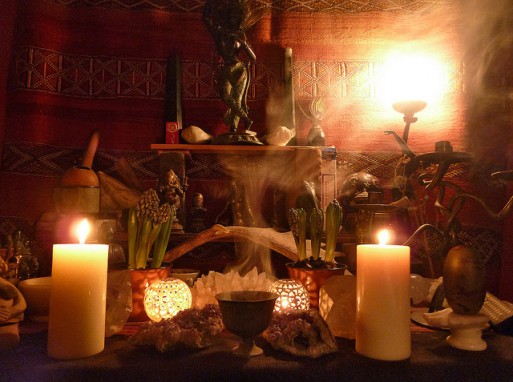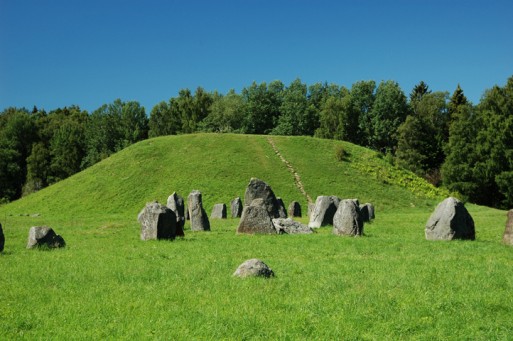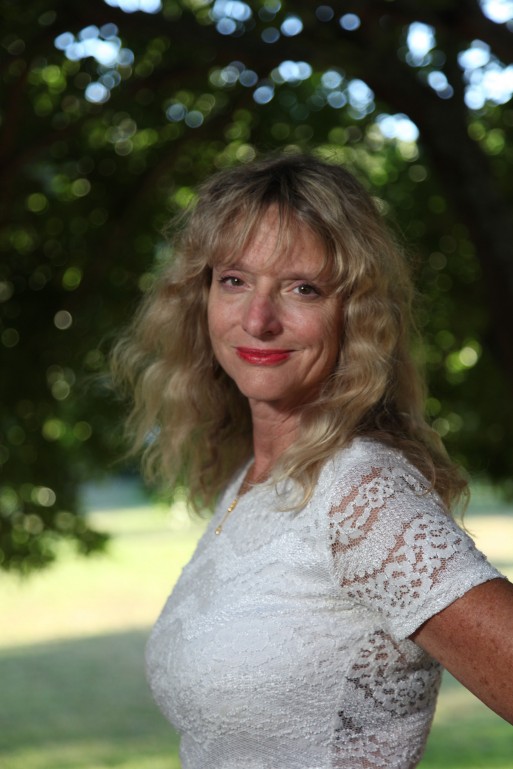In honor of Halloween, I had the opportunity to speak with Wiccan Priestess Cerridwen Fallingstar. At sixty-two, she is stunning in a bright summer dress in the midst of a misty Marin County morning. Cerridwen’s eyes flicker with enthusiasm under long eyelashes as she talks about Samhain, (pronounced SAH-win) one of the two chief Wiccan holidays. Cerridwen is a modern witch and knows the subject well, having spent a lifetime researching, teaching, practicing and writing about pagan traditions. While growing up in an agnostic household, she had, from a young age, stunned her parents by recalling in detail past life events that could not be attributed to her childhood. At twenty-two, Cerridwen had discovered the Goddess Movement with its reverence for the feminine, belief in reincarnation and an acceptance of death as a part of nature’s cycle. To her, “It was like coming home.”
Tradition should be something that’s alive and can change because if it’s not changing it’s dead.
While writing her first novel The Heart of the Fire that takes place in Medieval Scotland, Cerridwen spent a lot of time following the footsteps of the ancients. She visited the Celtic burial mounds: barrows that dated from about 4000 BC up to 600 AD. The Celts first buried their dead in the ground, but later exhumed their bones and placed them on stone ledges together with the skulls of spirit animals particular to their clan. Inside these barrows, before the skulls illuminated by candles, the living would commune with spirits of their ancestors. There was no fear of death in these tombs, only acceptance. “Inside the energy was so sweet,” Cerridwen recalls.
Cerridwen tells how the veil between the realms of the dead and living is thin on Samhain. As the population experienced violent deaths brought on by wars and invasions, people became aware of evil and sought protection. Instead of candlelit skulls, turnips were carved in a shape of a human head, hollowed out and carried with candles burning inside to summon the spirits of beloved ancestors and to repel the malevolent ones. That’s how Jack O’Lantern came to be. Going from house to house, sharing food and connecting with their community was a part of the rite. Bonfires burned and mummers donned costumes and masks. “They were trying to show that this village already has evil spirits. Apparently, evil spirits are not that bright and can be fooled by people in costume,” Cerridwen laughs. She approaches her faith with both reverence and humor.
Death was a part of the great unending circle that gave hope and knowledge that both life and summer will return. “There is no end to the circle no end, there is no end to life no end,” goes the pagan chant.
The smell of death was in the air: harvests were gathered; herds were culled in preparation for winter and their meat was smoked and salted. The season signified the death of summer and the birth of winter, bringing with it the feminine principles of moisture, darkness and winter. Death was a part of the great unending circle that gave hope and knowledge that both life and summer will return. “There is no end to the circle no end, there is no end to life no end,” goes the pagan chant.
With this cyclical view of nature came the belief in reincarnation and in a mythical Summerland or the Isle of Apples, a place to which the departed went to rest and heal before returning to the human world. Bobbing for apples symbolized crossing water to the blessed land and grabbing the apple with teeth was a grasp for immortality.
During the Middle Ages, the Roman Catholic Church often integrated pagan traditions into Christianity to make them more palatable to the converts. There was what Cerridwen refers to as “a mind – split into opposites” and the feminine aspects of the holiday became connected with evil. Samhain became All Souls’ Day, or Hallowmas, a day to honor all saints. The old traditions became distorted. The independent wise women—witches were seen as cackling temptresses that led men astray or brought ruin upon the pious. Samhain, like many ancient pagan traditions, has been altered, mutating over centuries into what we know today as Halloween—a day of ghouls, goblins and massive candy sales. The emotional and spiritual significance of Samhain was lost.
The ancient meaning of Samhain runs deep within the Wiccan tradition. To many, Samhain still offers a safe space to grieve, seek wisdom and celebrate the end of the harvest and the passing of the season from masculine to feminine in continuity and balance. Black candles adorn the Wiccan altar along with portraits of the dearly departed, as well as objects connected to their memories. Bones of animals summon the animal spirits since animal guides are a part of most pagan beliefs. Tables are set with offerings of food for dead and living and Jack O’Lanterns illuminate the space.
Honoring ancestors gives one a sense of continuity, helps to be less afraid of death and more accepting of it as a part of something greater
One does not have to be a pagan to honor ancestors. Nor do you need to use black candles or bones if it doesn’t feel comfortable. “Don’t scare yourself,” Cerridwen counsels. She encourages the idea of people creating their own traditions that they can relate to. She advises, “Put your grandmother’s bright red scarf and flowers on the table along with the photos. Share special memories and stories with those close to you. Tradition should be something that’s alive and can change because if it’s not changing it’s dead.” Wicca does not embrace strict rules or doctrines. “Do what you will, harm none” is at the core of Wiccan moral code.
Cerridwen believes that having rituals makes one feel part of the web of life. Individual life is small and short, but honoring ancestors gives one a sense of continuity, helps to be less afraid of death and more accepting of it as a part of something greater, a blessing just like sleep. Night is not bad. It’s a time to rest. Death is a time to rest. Earth rests and spirits need rest too.
Check out more cultural traditions about death here.

 Beyond Halloween
Beyond Halloween





 Our Annual Seven Holiday Gifts for Someone Who Is Grieving, 2024 Edition
Our Annual Seven Holiday Gifts for Someone Who Is Grieving, 2024 Edition
 “Making Mobiles” by Karolina Merska
“Making Mobiles” by Karolina Merska
 “Hands Up to the Sky” by Michael Franti & Spearhead
“Hands Up to the Sky” by Michael Franti & Spearhead














